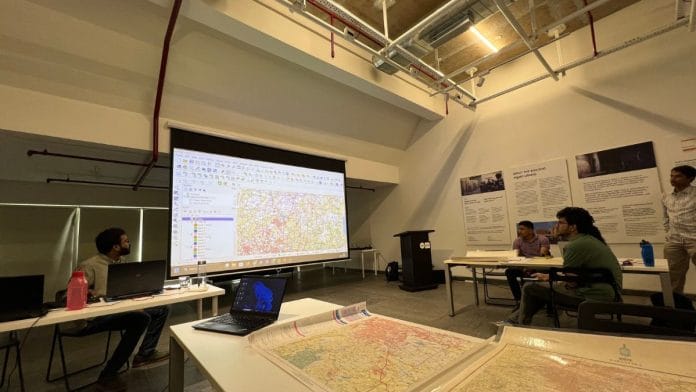Bengaluru: In a large room at the Science Gallery Bengaluru, young people milled around four large tables, poring over historic paper maps. They are engrossed in the cartographic history of Bengaluru and detailed topology charts—looking for lakes.
Over the next four hours, the group—a mix of students and working professionals that comprised engineers and even professors—compared paper maps to satellite imagery, and used online tools to create digital maps. The objective was to map Bengaluru’s water bodies—new and old, dead and alive.
This workshop was part of a hydrology workshop called ‘Uncovering Bengaluru’s Hidden Lakes’ and is one of many that the Science Gallery Bengaluru offers every weekend, free of charge.
Hydrologist Shashank Palur who conducted the workshop was inspired to do this after he held a similar exercise online during Covid-19.

“We had around 60 people participating, some even in their 60s, who were invested in the lakes in their neighbourhood. We ended up discovering that there are over 1,300 urban and rural water bodies in Bengaluru,” he said, referring to the online workshop.
Bengaluru’s moving lakes
At first glance, it may seem redundant to map water bodies given the amount of data and satellite images. But that’s easier said than done.
“Who do you go to find how many water bodies are there in the city? Who has that data? It is not available with any agency,” said Palur.
This is further complicated by the fact that many lakes and water bodies in Bengaluru are not naturally occurring, and also appear and disappear over years at different locations depending on urbanisation and land use. In the past, rulers of the Bengaluru region were known to create water bodies that acted as reservoirs. As a result, many of them are not even named officially. Geolocated databases do not exist.

At WELL (Water, Environment, Land, and Livelihood) Labs, where Palur is a senior hydrologist, researchers work on sustaining urban water bodies, reducing Bengaluru’s reliance on the Cauvery, promoting livelihood in rural regions, and exploring sustainable uses of land and water, among other things.
Through research and such workshops, the institute gathers scientific information that can be applied to real-world policy.
In this workshop, Palur taught attendees how to see the evolution of a water body using physical maps and satellite imagery with openly available software like QGIS (Quantum Geographic Information System) and Earth Engine. They colour-coded the locations of water bodies on various template maps of the city. The physical maps they used for reference were official copies from the Survey of India, which are no longer available to view or download online. People can no longer buy them in their physical form either.
“These old maps are a documentation of a city’s history, and they should be publicly available to the citizens,” said Palur.
Participants also learned how to navigate different software, put them into other software, upload them all together and more to create a map—much like GitHub. These online workshops, thus, help create maps that eventually become available online.
Also read:
Enabling citizen contribution
During their session break, the eager amateur cartographers discussed among themselves the various ways in which water bodies benefit the city—whether by way of water storage or prevention of floods through drainage. One attendee pointed out how lakes sustain diverse ecosystems, offer water solutions to the poor, and are critical resources for urban wildlife.
Bengaluru was once celebrated as the City of Lakes but has succumbed to pollution and encroaching urbanisation that has destroyed several water bodies. Rapid urbanisation after the 1980s saw the city’s population rise nearly twenty-fold and led to a loss of over 1,000 lakes. In 1960, there were a documented 1,452 lakes in the city, mostly created by the community or various rulers. However, according to Biome International’s 2016 study, less than 200 remain today.

Sinchana Pavanje, who studies design at The Srishti-Manipal Institute of Art, Design, and Technology attended the workshop because her fourth-year pre-thesis subject is on how the global fashion and textile industry is among the largest polluters of lakes and rivers.
“I’ve just begun my research, and this workshop was great,” Pavanje said. “We got a lot of great insights into the different types of water bodies, and studying maps all the way from the ’70s helps us understand how the city evolved as well.”
(Edited by Zoya Bhatti)






